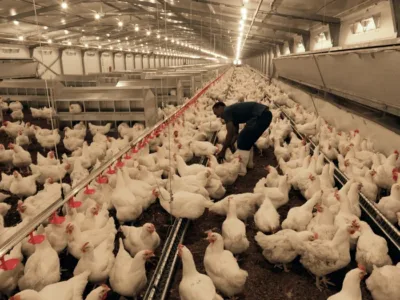Modern Technologies for Dust Detection in Poultry Farms

Dr. Majed Hamed Al Saegh / poultry pathologist / Australia
Modern technologies are revolutionising how dust is detected and monitored in poultry farms, helping to overcome the limitations of traditional methods like gravimetric sampling and optical particle counters. These advanced solutions provide real-time, precise, and automated dust monitoring, improving air quality management and reducing health risks for poultry and workers. Below are the key new technologies for dust detection in poultry farms:
- IoT-Based Dust Monitoring Systems
How It Works:
IoT sensors are deployed in poultry farms to continuously monitor air quality, including dust levels. The sensors connect to a central system that collects and analyses data in real time. Alerts are sent to farmers when dust levels exceed permissible thresholds.
Advantages:
- Continuous, real-time monitoring.
- Integration with ventilation and filtration systems for automated responses.
- Remote access to data via smartphones or computers.
- Cost-effective and scalable for large farms.
Examples:
- Smart air quality monitors with particulate sensors (PM2.5, PM10).
- Farm management platforms integrated with environmental monitoring systems.
- Laser-Based Air Quality Sensors
How It Works:
These sensors use laser scattering technology to detect and measure the size and concentration of particles in real time. They offer high precision and sensitivity for detecting fine particles (<1 micron), which is critical in poultry environments.
Advantages:
- Compact design and low maintenance.
- High accuracy, even for irregularly shaped particles like poultry dust.
- Continuous data collection and integration with automated farm systems.
Applications:
- Monitoring dust levels during high-activity periods such as feeding or cleaning.
- Providing insights to optimise ventilation systems.
- Drone-Based Dust Detection
How It Works:
Drones equipped with air quality sensors fly through poultry houses to map dust concentrations. Data is transmitted in real time to a central system for analysis and visualisation.
Advantages:
- Effective for monitoring large or hard-to-reach areas.
- Reduces the need for stationary sensors.
- Enables targeted interventions in areas with high dust concentrations.
Applications:
- Ideal for large poultry farms or those with uneven ventilation.
- Conducting periodic air quality assessments without disrupting operations.

- Machine Vision and Artificial Intelligence (AI)
How It Works:
Cameras installed in poultry houses capture images or videos of airborne dust. AI algorithms process visual data to quantify dust levels and detect trends.
Advantages:
- Non-invasive and easy to implement.
- Capable of differentiating between dust and other particulates like feathers.
- Provides real-time analysis and predictive insights.
Applications:
- Automated air quality monitoring as part of farm management systems.
- Early detection of dust accumulation to prevent respiratory issues in poultry.
- Electrostatic Precipitation Sensors
How It Works:
These sensors use electrostatic precipitation to attract and capture airborne particles. Collected particles are analysed to determine size distribution and concentration.
Advantages:
- Suitable for detecting fine and ultra-fine particles.
- Operates continuously with minimal maintenance requirements.
- Provides detailed particle composition analysis.
Applications:
- Monitoring dust in high-particle-density areas like feeding zones.
- Providing data for improving air filtration systems.
Conclusion
Adopting modern dust detection technologies in poultry farms enhances air quality management and reduces health risks. IoT systems, laser-based sensors, drones, AI-powered solutions, and electrostatic precipitation sensors offer precise, real-time, and scalable monitoring. By integrating these technologies, poultry farms can improve productivity, ensure animal welfare, and meet environmental and health standards.



